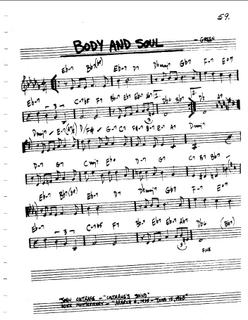
The other day I played a jazz trio gig and we decided to play the John Green standard Body and Soul. I've played this ballad quite a few times in the past, and it's is a very tightly crafted example of the 32 bar song form. It has a great melody and great harmonies, which always make it a lot of fun to play and solo over.
Unlike most standard 32-bar tunes, this one is unusual in that the bridge appears to completely change keys. (In fact, in the real book, they actually wrote the key change in--perhaps far easier than writing in all those naturals!) It is not uncommon for 32 bar songs to do this. Most songs, however, do not actually contain a change of key written into the music. Most bridges move away from the tonality of the opening and ending key, but usually closely related to the original. Body and Soul, however, seems to move VERY far away from the original key.
The opening key signature has five flats--either Db major or Bb minor. In this case, it begins on a ii chord in Db. Look at the end of the A phrases. Clearly it finds tonic in a Db major tonality. But the bridge moves to D major, a very distant key from Db indeed.
As I got to thinking about it, I realized there is a relationship between the two tonalities that ties them together closer than a simple or arbitrary half-step relationship. It is not very difficult to justify this relationship from an analytical perspective, nor is it very difficult to justify the relationship between the two keys from an historical perspective. One can see (hear) the tonal relationship exploited in tonal European art music over a couple of centuries. The answer can be found in a town in Italy. Any ideas?
![]()
